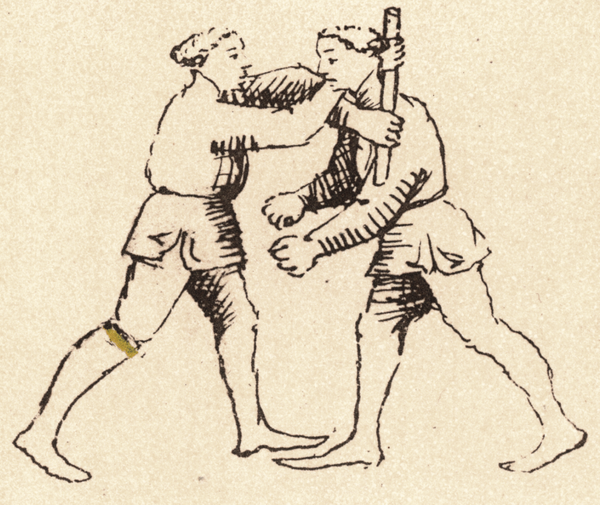Within the fencing traditions of the staff, we find a written entry in the manuscript Cod.Hs.3227 of the Germanisches Nationalmuseum in Nuremberg, Germany. This manuscript is dated to around 1389.
This Latin-German manuscript collection includes texts with technical, medical, astrological texts and several fencing lessons. It is the oldest known manuscript which documented the fencing techniques and theory of Johannes Liechtenauer, a fencing master whose influence lasted well into the 16th century and apparently spread far and wide.
The manuscript is composed of text only. There are no illustrations. The vast martial arts related topics are as follows:
• On the Hardening Iron (sheet 27 – 29)
• Johann Liechtenauer: The Art of Fencing, Part 1 (sheet 32 – 85)
• Fencing Regulations of other Masters, rhymed by Hanko Döbringer (sheet 91 – 102)
• Prose Text About School Fencing.
• Johann Liechtenauer: The Art of Fencing, Part 2 (sheet 111 – 126)
• “This Now is About Wrestling (=unarmed combat)”
• Apostil to the Bare Fencing (=without armor) of Master Liechtenauer (sheet 133 – 135)
• “Here Commences the Fencing with the Shield”
• “Here Commences the Fencing with the Staff” (sheet 78)
• “Here Commences the Fencing with the Long Knife” (sheet 169 – 170)
• “Here Commences the Fencing with the Sword” (sheet 173 – 175)
• Johann Liechtenauer: The Art of Wrestling (=unarmed combat) (sheet 177 – 183)
Occasionally the text simply breaks off after a few introductory lines, such as on sheet 78r, where the following self-explanatory text on “fencing with the staff” is found as one of the earliest actual text book style descriptions of martial arts as a craftsmanship:
[78r] Here Commences the Fencing with the Staff
“He who aspires to learn the fencing with the staff should first of all know and note that a proper staff should be twelve spans long. And the fencing with the staff derives from the fencing with the sword. And just as one fences with the sword, so one should also fence with the staff. And the principles that belong to the sword, such as audaciousness, quickness, stratagems, intelligence, etc, also belong to the staff.”
Here the text breaks off. However, this whole work constitues the beginning of text book style combat descriptions which layed down the teachings of an actual master for study. It is important to note that there was a staff fencing as we know it, with a staff of “twelve spans,” length, i.e. somewhere between 1.80m and 2.40m.
Soon text would be accompanied by illustrations, and this would continue to be the standard form for combat decriptions for the next six-hundred years, until the 20th century. Within this vast epoch, only rather recently films, the internet, and Youtube sort of disrupted that original form of combat instructions.
![[78r] Hie hebt sich an fechten mit der stangen](http://ryukyu-bugei.com/wp-content/uploads/2018/08/Döbringer-Hier-hebt-sich-an-das-Fechten-mit-der-Stange.jpg)
[78r] Hie hebt sich an fechten mit der stangen. Source: Germanisches Nationalmuseum, Nuremberg.
The places of Fiore’s activity – Udine, Padua, Pavia, and Ferrara – at that time belonged to the territory of the Holy Roman Empire, which can be said to have begun with Otto the Great (Italian: Ottone il Grande) – German king from 936, Italian king from 951, and Holy Roman Emperor from 962 – and lasted until 1806.
While Fiore himself might not be considered a significant master in the evolution of fencing in Central Europe, he did prepare one of the first illustrated fencing books which shows a potpourri of techniques derived from the eminent “German” and “Italian” fencing schools of that era. Besides the regular armed or unarmed fight on foot or horseback, Fiore also covered topics such as the bastoncello, or plays of a short stick, such as shown below and bearing the description:
“With a short staff I bind your neck, And if I fail to bring you into the ground, you can consider yourself lucky.”

Digital image courtesy of the Getty’s Open Content Program. Translation by Colin Hatcher.





© 2018 – 2019, Andreas Quast. All rights reserved.
